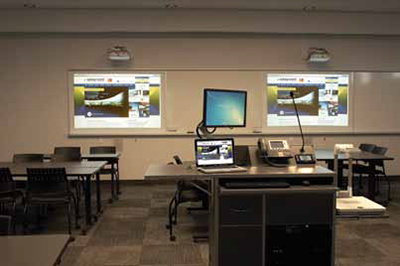Flexible classroom design allows professors and students ultimate mobility and access to technology when presenting.When the administration at Sheridan College decided to build a new wing of flexible classrooms for its Brampton Campus, they turned to Advanced to install new “classrooms of the future” that would enhance capabilities for professors and students. Advanced outfitted 20 classrooms with new computers, wireless microphones, document cameras, movable podiums, and projectors in each room. And because technology is only as good as the people using it, they made sure that every room has identical controls and can be used with very little training.
“We’ve been working with Sheridan College for over 12 years now, so they knew that we were capable of turning their new wing of classrooms into interactive classrooms of the future,” said Mark McPherson, vice president at Advanced. “Sheridan wanted to create a flex classroom environment that would provide students and professors the ability to interact and lecture in various ways, and we integrated AV solutions that let them do just that.”
Sheridan came to Advanced with a flexible classroom design that differs from the traditional, podium-in-front-of-class layout, and allows professors and students ultimate mobility and access to technology when presenting.
“We knew we had a design that was different from anything else being done in college classrooms, so we needed an AV integrator that could take our idea and make it a reality,” said Trevor Hanekamp, ICT architect at Sheridan College. “Advanced presented us with a proposal that offered an innovative and budget-conscious AV solution for our flex classrooms. In the end, they turned each of these classrooms into hi-tech multimedia facilities, and the professors and students couldn’t be happier with the new easy-to-use flex classrooms.”
For the initial project, Advanced partnered with Just Add Power to install AV equipment in 19 flex classrooms and one room designated the college “Co-Lab.” The flex classrooms include up to six NEC NP-U310W projectors, and every classroom features Dell computers and AVerMedia 350+ document cameras. Audio components include Extron DMP 44 LC digital matrix processors, Extron power amplifiers, and Shure wireless gooseneck microphones. Because every room uses an identical Crestron control panel, educators can easily teach a class in any of the rooms, making scheduling much simpler. Other control components include a Kramer FC-10ETH RS-232 to ethernet, and a Kramer RK-4PT rack mount for FC-10ETH.
Each flex classroom is designed to accommodate network-connected mobile podiums, allowing educators to present their lessons from any area of the room. Sheridan also wanted to eliminate traditional bulky equipment racks from the classrooms, so Advanced designed and installed an innovative equipment racking system mounted to the ceiling, taking up no more space than one ceiling tile.
The Co-Lab is a six-projector room that consists of the same video and audio components as the flex classrooms and features an Exact podium that allows educators to control four video sources simultaneously. The Co-Lab is equipped with two modes, classroom and team, that allow for different methods of presentation. Classroom mode lets educators present their lessons on the main projector screen, while team mode allows for projected content to be distributed to six separate areas of the classroom, perfect for group work. The room also includes a Kramer scaler for video switching.
“This really is a one-of-a-kind AV setup,” said Wayne Derby, vice president of engineering and technical services at Advanced. “Very few educational facilities in North America have deployed AV solutions that provide both professors and students such accessible, mobile and easyto- use equipment. Sheridan put a lot of thought into what they wanted for their new wing of rooms, and they decided that they needed a topof- the-line template that they wouldn’t have to change every semester, and would be very simple to use. Typically, when you integrate this kind of equipment, you have to devote a lot of time to system training. With this project, minimal training was required, as their system is so innovative. In the end, they couldn’t have been happier with the result.










